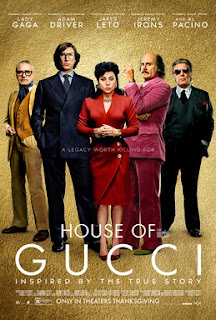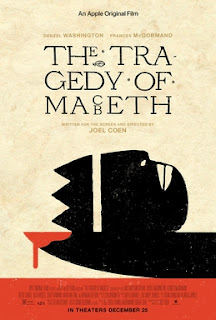Opening this weekend:
King Richard--This biopic concerns the early rise of two of the greatest athletes of our time, Venus and Serena Williams. I found myself feeling a pang of sympathy for the casting director; how the hell is anyone supposed to find young actresses who plausibly suggest those two demigoddesses, and who presumably had to have at least some aptitude for tennis as well?
Saniyya Sidney and Demi Singleton got the parts, and play them well, with unaffected sweetness and physical confidence that brings the tennis scenes to life. But we catch a glimpse of the genuine articles in some video footage near the end, and realize that there's no replacement for them.
This doesn't matter much, however; the real focus of the film, as the title indicates, is Richard Williams, their father and, in their earlier years, their largely self-taught coach and manager. A security guard from Louisiana living in L.A., the elder Williams, played by Will Smith, is shown here to have essentially created his two world-beating prodigies from scratch.
The movie begins with him explaining to baffled white tennis coaches and sponsors he's trying to recruit that he wrote a plan to develop his girls into champs before they were born. Then he talked his wife Brandi (Aunjanue Ellis) into having two more children for this purpose (they both had children from previous relationships), and coached them rigorously, on dangerous, gang-infested neighborhood tennis courts in Compton.
You can hardly blame the guys listening to Williams for dismissing him as a crackpot, or even his disapproving neighbor for wondering if he's working them too hard. The point of the movie, however, is that almost everything Williams predicted came spectacularly true. It also shows him teaching them humility and good sportsmanship, almost tyrannically.
I think you'd have to have a piece of your soul missing not to find this story, briskly directed by Reinaldo Marcus Green from a script by Zach Baylin, at least a little bit moving and inspiring. The role fits Smith like a glove, both in his tireless positivity and his exhausting eccentricity, and we feel it when he gets angry at the racist condescension of the white tennis bigshots. And it's also hard not to love the character's preaching to his girls against unsportsmanlike braggadocio, and his disgust with abusively competitive tennis parents.
But there's no way around it, there's something crazy, almost science-fictional, about this story as well, as if the champs were cloned and programmed for their destiny. This sunny movie shows us happy, well-rounded, singing, squabbling little girls; if either Venus or Serena ever thought they might want to do something else with their lives we don't see it. Probably the world is full of sports parents with grandiose visions like this; what makes King Richard seem far stranger than fiction is that in this case the vision wasn't delusional.
Kurt Vonnegut: Unstuck in Time--This portrait arrives more than thirty years after it was begun. Over the decades of its gestation, the director, Robert B. Weide, became a talking head and a first-person presence in the film, explaining what Vonnegut means to him, how the project began, and (sort of) explaining the delay in completing it.
In this way it's a bit like many of Vonnegut's own books, especially his swansong novel Timequake, with his authorial intrusions that foreshadowed and influenced the "meta" techniques of contemporary lit. Weide, a veteran documentarian as well as a producer and director of Curb Your Enthusiasm, had idolized Vonnegut since high school, and wrote to him proposing the project in the '80s. The men hit it off, and as shooting continued they swiftly became close friends, maybe even best friends.
Thus, along with remarkable access to archival material--vivid home movies from the author's childhood and youth, marked-up manuscripts, rejection slips, drawings etc (and, be forewarned, some hard-to-watch wartime footage)--the interviews Weide captured of Vonnegut, teasing, ruminating, laughing inappropriately at grim stories, seem unusually candid and intimate. Vonnegut's children and stepchildren also appear, as well as friends and colleagues ranging from John Irving to Morley Safer, and generous chunks of his prose are heard, read by Sam Waterston when no recording of Vonnegut is extant.
Vonnegut has been much on my mind of late, as I had the opportunity to visit the Kurt Vonnegut Museum and Library in Indianapolis this past August; some of the artifacts I saw on display there are shown in the film. Although I've been a voracious Vonnegut reader since about the time that Weide started, I learned much from Kurt Vonnegut: Unstuck in Time. It's a chronicle of a remarkable life; it's also a chronicle of an enviable friendship.






















































